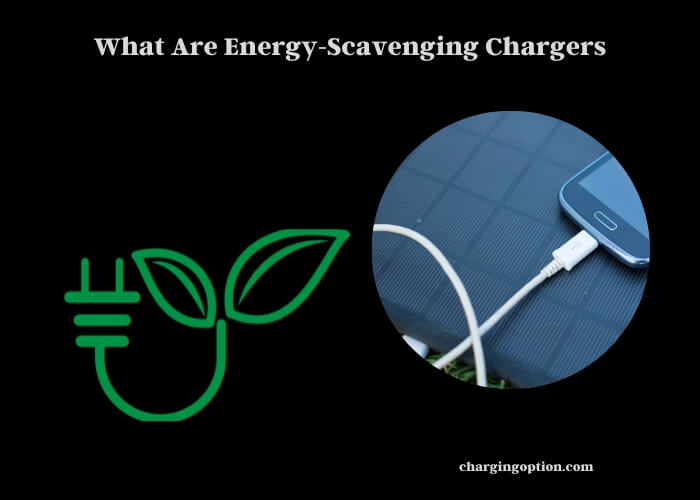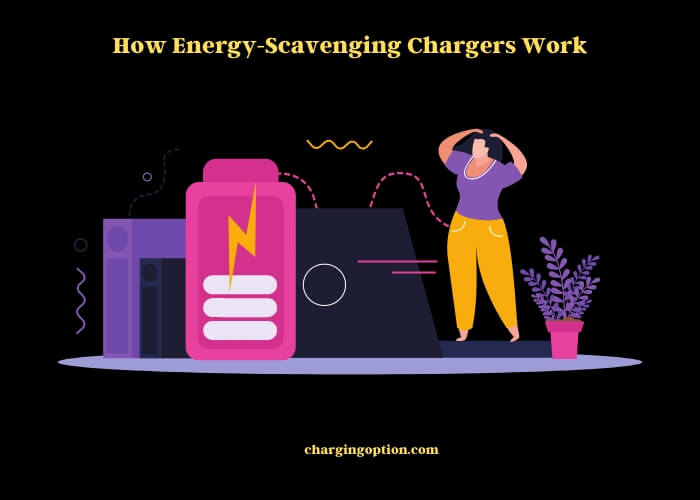“Hey, what’s eating up all the power?” Quite literally, our modern world is. Our appetite for energy seems insatiable, doesn’t it? That’s where energy-scavenging chargers come into the picture – sustainable heroes in our energy-hungry world. But what exactly are these devices?

What are Energy-Scavenging Chargers?
Haven’t heard of energy-scavenging chargers before? Don’t fret; they’re fairly new kids on the block. These devices harness ambient energy from the environment – such as light, heat, or motion – and convert it into electrical power. So, instead of letting energy go to waste, we’re rounding it up for a second tour of duty. Pretty nifty, huh?
Understanding Energy Harvesting
Imagine this: You’re out and about, your phone’s battery is teetering on the brink of extinction, and you’re far from a power outlet. Sounds like a nightmare, right? Well, energy-scavenging chargers are dream-weavers that rescue us from such predicaments. They catch the energy that’s always around us but seldom used – like a catcher in the rye of energy.
Types of Energy-Scavenging Chargers
There are different types of energy-scavenging chargers, each with a unique ability to harvest energy from various sources. Let’s break it down:
- Thermal Energy Harvesters: These hotshots tap into heat differences in the environment. More details
- Kinetic Energy Harvesters: These movers and shakers draw energy from motion or vibrations. For details, visit this website.
- Solar Energy Harvesters: These sun-seekers utilize light energy, specifically from our ever-generous Sun.
- RF Energy Harvesters: These radio stars scavenge energy from ambient radio frequency signals. Learn details.
How Energy-Scavenging Chargers Work
Ever wondered how these ingenious devices work? They employ various transduction mechanisms to convert ambient energy into usable electrical power. It’s like the Midas touch, but for energy!

Transduction Methods in Energy-Scavenging Chargers
Without getting too science-y, here’s a quick look at the transduction mechanisms employed by these chargers:
- Thermoelectric Effect: In thermal energy harvesters, this phenomenon is used to convert temperature differences into electricity. You can learn more in Wikipedia.
- Piezoelectric Effect: Kinetic energy harvesters leverage this effect to convert mechanical strain into electrical energy. For more information visit this website.
- Photovoltaic Effect: Solar energy harvesters use this mechanism to transform light energy into electricity. Click here for details info.
- Electromagnetic Induction: RF energy harvesters use this process to generate power from radio waves. Details are here.
Applications of Energy-Scavenging Chargers
Now, you might be thinking, “These chargers sound great, but where can we use them?” The answer? Almost anywhere!
Energy-Scavenging Chargers in Electronics
Frequent travelers, rejoice! Energy-scavenging chargers can be a boon for charging portable electronic devices, like smartphones and laptops, on the go. No more hunting for outlets in airports or cafes!
Energy-Scavenging Chargers in IoT Devices
With the rise of IoT devices in homes and industries, energy-scavenging chargers could be a game-changer. Think about it – IoT devices that power themselves from the environment, reducing our reliance on the grid and extending their operation time. Ain’t that something?
Energy-Scavenging Chargers in Remote Locations
Areas where power supply is inconsistent or unavailable could significantly benefit from these chargers. Imagine being able to power a remote research station or a lighthouse with ambient energy. Pretty cool, huh?
Benefits and Limitations of Energy-Scavenging Chargers
Just like anything else, energy-scavenging chargers come with a set of pros and cons. Let’s weigh them out, shall we?
Advantages of Energy-Scavenging Chargers
- Sustainable Energy Use: These chargers make the most of the energy we’ve got, leading to efficient and sustainable power use.
- Portability: Their small size and independence from power outlets make them incredibly portable.
- Maintenance-Free: With no need for battery replacements, these chargers require minimal maintenance.
Drawbacks of Energy-Scavenging Chargers
- Dependence on Ambient Conditions: Since they rely on ambient energy, they might not perform well in certain conditions.
- Lower Power Output: These devices typically generate less power than conventional chargers.
- Higher Initial Costs: The advanced technology in these chargers may make them more expensive upfront.
The Future of Energy-Scavenging Chargers
So, what’s next for energy-scavenging chargers? Will they become a fixture in our energy-efficient future?
Energy-Scavenging Chargers in Green Tech
Given their potential to reduce energy waste, it’s safe to say these chargers will have a significant role in green technology. The future is green, and energy-scavenging chargers are ready to take the lead.
Development in Energy-Scavenging Tech
As technology advances, we can expect to see even more efficient and versatile energy-scavenging chargers. Brace yourself; the future’s looking bright!
Here Are Some Videos to Quench Your Thirst for Knowledge
Can We Harness Electricity From Lightning?
What If We Harnessed Zero-Point Energy?
Harnessing The True Power Of Atoms | Order And Disorder Compilation
FAQs
1. What are energy-scavenging chargers?
They’re devices that capture ambient energy from their surroundings (like light, heat, or motion) and convert it into electrical power.
2. How do energy-scavenging chargers work?
They use transduction mechanisms to transform various types of ambient energy into usable electricity.
3. Where can I use energy-scavenging chargers?
You can use them almost anywhere – from charging portable devices on the go to powering IoT devices and facilities in remote locations.
4. What are the benefits of using energy-scavenging chargers?
They promote sustainable energy use, are portable, and require minimal maintenance.
5. What are the limitations of energy-scavenging chargers?
Their performance depends on ambient conditions, they usually generate less power, and they can be more expensive upfront.
6. What’s the future of energy-scavenging chargers?
With advancements in technology and the push for green tech, the future of energy-scavenging chargers looks promising.
Conclusion
Energy-scavenging chargers are game-changers in our quest for sustainable energy use. Sure, they may have a few kinks to iron out, but their potential to redefine our energy consumption is undeniable. So, next time you’re about to plug in your charger, remember – there’s a whole lot of energy waiting to be harnessed!
Read more:
